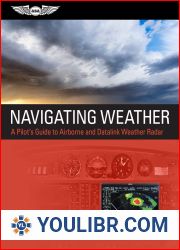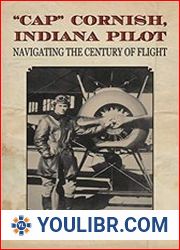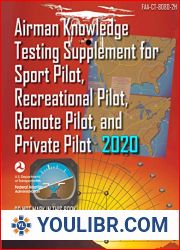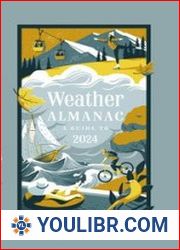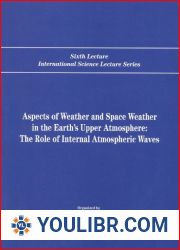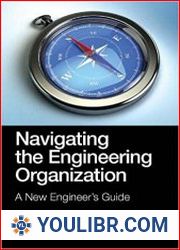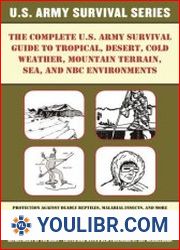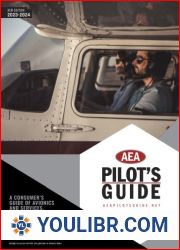
BOOKS - Navigating Weather: A Pilot's Guide to Airborne and Datalink Weather Radar

Navigating Weather: A Pilot's Guide to Airborne and Datalink Weather Radar
Author: David Ison
Year: December 15, 2021
Format: PDF
File size: PDF 34 MB
Language: English
Year: December 15, 2021
Format: PDF
File size: PDF 34 MB
Language: English
Weather radar information is one of the most valuable tools available to pilots to ensure safe, efficient, and comfortable flight operations. Onboard weather radar allows pilots to tactically navigate near and around severe weather with confidence. And with the advent of datalink radar data systems, pilots of all types of aircraft and skill levels can easily access similar vital information. Yet pilots must understand how to use these technologies and their potential flaws to avoid inadvertently getting too close to or penetrating severe weather, which could obviously have detrimental outcomes.Author Dr. David Ison takes you through the fundamental knowledge and skills necessary to operate both airborne and datalink weather radar. With a focus on simplicity and real-world application, Dr. Ison introduces and explains the essential concepts of radar operation and interpretation. Beginning with radar and severe weather theory, he covers attributes of inclement weather phenomena, how they are detected, and how pilots can evaluate these conditions through available radar sources. Airborne weather radar essentials such as attenuation, tilt management, contouring, and gain are explained with real-world examples. The text outlines advanced features including auto-tilt, turbulence detection, wind shear warning systems, and terrain mapping and provides operational strategies for all phases of flight. The detailed sections on datalink radar information explain how the system works, how to use available data, and common pitfalls. Dr. Ison describes the advantages and disadvantages of both airborne and datalink radar systems to help pilots understand the best and most effective use of each.Each chapter provides case examples, concept questions to test your understanding, and scenarios to assess your judgment and evaluation skills. Regardless of your current skill level - and whether you are just considering adding datalink radar to your toolkit or have been flying with airborne radar for years - this book can serve as a fundamental reference on using radar data in flight.
télécharger le fichier pdf Navigation Météo A Pilotes Air and Datalink Météo Guide Radar скачать файл PDF Навигация Погода A Пилоты Руководство по воздушной и Datalink Погода Радар download pdf file PDFファイルをダウンロード ナビゲーション天気Aパイロット航空とデータリンクマニュアル天気レーダー descargar archivo pdf Navegación Tiempo A Pilotos Guía Aérea y Datalink Tiempo Radar pdf 파일 다운로드 내비게이션 날씨 A 조종사 공기 및 데이터 링크 수동 날씨 레이더 下载 pdf 文件 導航天氣A飛行員航空和Datalink天氣雷達指南
PDF-Datei herunterladen Navigation Wetter A Piloten Anleitung zu Luft und Datalink Wetter Radar descarregar ficheiro pdf Navegação Tempo A Pilotos Manual Aéreo e Datalink Tempo Radar pdf dosyasını indir Navigasyon Hava A Pilotlar Hava ve Datalink Manuel Hava Radar download pdf file Navigating Weather: A Pilot's Guide to Airborne and Datalink Weather Radar להוריד קובץ PDF מזג אוויר ניווט A טייסים ומכ "ם מזג אוויר ידני Datalink pobierz plik pdf Nawigacja Pogoda A Piloci Powietrze i Datalink Manual Pogoda Radar Scarica il file pdf Navigazione Meteo A Piloti Guida aerea e Datalink Meteo Radar تنزيل ملف pdf طقس الملاحة رادار الطقس اليدوي للطيارين الجوي وداتالينك
Le informazioni radar meteorologiche sono uno degli strumenti più preziosi a disposizione dei piloti per consentire voli sicuri, efficienti e confortevoli. Il meteorolocalizzatore di bordo permette ai piloti di spostarsi con sicurezza tatticamente e intorno al tempo duro. E con l'introduzione di sistemi di dati radar datalink, i piloti di tutti i tipi di aerei e livelli di competenze possono facilmente accedere a informazioni essenziali simili. Tuttavia, i piloti devono capire come utilizzare queste tecnologie e i loro potenziali difetti per evitare di avvicinarsi involontariamente al clima duro o penetrare, che ovviamente può avere effetti dannosi. L'autore, il dottor David Ayson, vi mostrerà le conoscenze fondamentali e le competenze necessarie per lavorare con il radar meteorologico sia nell'aria che nel canale di trasmissione dei dati. Focalizzandosi sulla semplicità e l'applicazione reale, il dottor Ayson presenta e spiega i concetti fondamentali del lavoro e l'interpretazione dei radar. Partendo dal radar e dalla teoria del clima duro, esso copre gli attributi dei fenomeni meteorologici avversi, le modalità di rilevazione e il modo in cui i piloti possono valutare queste condizioni attraverso le fonti radar disponibili. I principali componenti della radar meteorologica aerea, come l'indebolimento, il controllo dell'inclinazione, il trattamento del contorno e il rafforzamento, sono spiegati su esempi reali. Il testo descrive funzioni avanzate, tra cui inclinazione automatica, rilevamento delle turbolenze, sistemi di allarme per lo spostamento del vento e mappatura del terreno, e fornisce strategie operative per tutte le fasi di volo. Sezioni dettagliate dedicate alle informazioni radar del canale dati spiegano come funziona il sistema, come utilizzare i dati disponibili e le pietre sottomarine comuni. Il dottor Ayson descrive i vantaggi e i difetti dei sistemi radar di base aerea e trasmissione dati per aiutare i piloti a comprendere l'uso migliore e più efficiente di ciascuno di essi. Ogni capitolo fornisce esempi di esempi, domande concettuali per verificare la vostra comprensione e scenari per valutare il tuo giudizio e le tue abilità di valutazione. Indipendentemente dal tuo livello di competenze attuale - e se consideri solo l'aggiunta di un radar del canale dati al tuo utensile o se hai viaggiato con il radar di bordo per anni - questo libro può essere un riferimento fondamentale per l'utilizzo dei dati radar in volo.
L'information radar météorologique est l'un des outils les plus précieux dont disposent les pilotes pour assurer des vols sûrs, efficaces et confortables. Le météorologue de bord permet aux pilotes de naviguer tactiquement à proximité et autour des intempéries. Et avec l'arrivée des systèmes de données radar datalink, les pilotes de tous les types d'avions et de tous les niveaux de compétence peuvent facilement accéder à des informations vitales similaires. Cependant, les pilotes doivent comprendre comment utiliser ces technologies et leurs inconvénients potentiels pour éviter de s'approcher ou de pénétrer involontairement dans des conditions météorologiques difficiles, ce qui peut évidemment avoir des conséquences néfastes. L'auteur, le Dr David Ison, vous présentera les connaissances et les compétences fondamentales nécessaires pour travailler avec un radar météorologique dans l'air et dans un canal de données. En se concentrant sur la simplicité et l'application réelle, le Dr Aison présente et explique les concepts de base du travail et de l'interprétation des radars. En commençant par le radar et la théorie de la météo sévère, il couvre les attributs des phénomènes météorologiques défavorables, les moyens de les détecter et la façon dont les pilotes peuvent évaluer ces conditions à l'aide de sources radar disponibles. Les principaux composants du radar météorologique aérien tels que l'atténuation, le contrôle de l'inclinaison, le traitement de contour et le gain sont expliqués à partir d'exemples réels. Le texte décrit les fonctions avancées, y compris l'inclinaison automatique, la détection des turbulences, les systèmes d'avertissement de cisaillement du vent et la cartographie du terrain, et fournit des stratégies opérationnelles pour toutes les phases du vol. Des sections détaillées sur les informations radar du canal de données expliquent comment fonctionne le système, comment utiliser les données disponibles et les pièges communs. M. Ison décrit les avantages et les inconvénients des systèmes radar de base aérienne et de transmission de données pour aider les pilotes à comprendre la meilleure et la plus efficace utilisation de chacun d'eux. Chaque chapitre donne des exemples, des questions conceptuelles pour tester votre compréhension et des scénarios pour évaluer vos jugements et vos compétences en évaluation. Quel que soit votre niveau actuel de compétence - et que vous envisagiez seulement d'ajouter un radar de liaison de données à votre boîte à outils ou de voler avec un radar embarqué depuis de nombreuses années - ce livre peut servir de référence fondamentale sur l'utilisation des données radar en vol.
Informações meteorológicas de radar são uma das ferramentas mais valiosas disponíveis pelos pilotos para garantir voos seguros, eficientes e confortáveis. O sistema meteorológico de bordo permite aos pilotos navegar com segurança taticamente perto e em torno do tempo duro. E com os sistemas de dados de radar datalink, pilotos de todos os tipos de aeronaves e níveis de qualificação podem facilmente acessar informações essenciais semelhantes. No entanto, os pilotos devem entender como usar essas tecnologias e suas potenciais deficiências para evitar a aproximação involuntária do tempo severo ou a penetração, o que obviamente pode ter consequências prejudiciais. O autor, Dr. David Ayson, vai apresentar-lhe os conhecimentos e habilidades fundamentais necessários para lidar com o radar meteorológico, tanto no ar como no canal de dados. Com foco na simplicidade e na utilização real, o Dr. Aison apresenta e explica os conceitos básicos de trabalho e interpretação dos radares. A partir do radar e da teoria do tempo severo, ele abrange atributos de fenômenos climáticos adversos, maneiras de detectá-los e como os pilotos podem avaliar essas condições através de fontes de radar disponíveis. Os principais componentes de radar meteorológico aéreo, como enfraquecimento, controle de inclinação, tratamento de contorno e reforço, são explicados em exemplos reais. O texto descreve funções avançadas, incluindo inclinação automática, detecção de turbulência, sistemas de alerta de deslocamento de vento e mapeamento da área, além de fornecer estratégias operacionais para todas as fases de voo. Seções detalhadas sobre informações de radar do canal de dados explicam como o sistema funciona, como usar dados disponíveis e pedras submarinas compartilhadas. Dr. Aison descreve as vantagens e desvantagens dos sistemas de radar de base aérea e de dados para ajudar os pilotos a compreender o melhor e mais eficiente uso de cada um deles. Cada capítulo apresenta exemplos de exemplos, questões conceituais para testar sua compreensão e cenários para avaliar seus julgamentos e habilidades de avaliação. Independentemente do seu nível de qualificação atual - e se você considera apenas adicionar um radar de dados ao seu instrumento ou voar com um radar de bordo por muitos anos - este livro pode servir de referência fundamental para o uso de dados de radar em voo.
Метеорологическая радиолокационная информация является одним из самых ценных инструментов, доступных пилотам для обеспечения безопасных, эффективных и комфортных полетов. Бортовой метеолокатор позволяет пилотам уверенно тактически ориентироваться вблизи и вокруг суровой погоды. А с появлением систем радиолокационных данных datalink пилоты всех типов самолетов и уровней квалификации могут легко получить доступ к аналогичной жизненно важной информации. Тем не менее, пилоты должны понимать, как использовать эти технологии и их потенциальные недостатки, чтобы избежать непреднамеренного приближения к суровой погоде или проникновения в нее, что, очевидно, может иметь пагубные последствия. Автор, доктор Дэвид Айсон, познакомит вас с фундаментальными знаниями и навыками, необходимыми для работы с метеорологическим радаром как в воздухе, так и в канале передачи данных. Сосредоточив внимание на простоте и реальном применении, доктор Айсон представляет и объясняет основные концепции работы и интерпретации радаров. Начиная с радиолокации и теории суровой погоды, он охватывает атрибуты неблагоприятных погодных явлений, способы их обнаружения и то, как пилоты могут оценить эти условия с помощью доступных радиолокационных источников. Основные компоненты воздушной метеорологической радиолокации, такие как ослабление, управление наклоном, контурная обработка и усиление, объясняются на реальных примерах. Текст описывает расширенные функции, включая автоматический наклон, обнаружение турбулентности, системы предупреждения о сдвиге ветра и картографирование местности, а также предоставляет операционные стратегии для всех фаз полета. Подробные разделы, посвященные радиолокационной информации канала передачи данных, объясняют, как работает система, как использовать доступные данные и общие подводные камни. Доктор Айсон описывает преимущества и недостатки радиолокационных систем воздушного базирования и передачи данных, чтобы помочь пилотам понять лучшее и наиболее эффективное использование каждой из них. В каждой главе приводятся примеры примеров, концептуальные вопросы для проверки вашего понимания и сценарии для оценки ваших суждений и навыков оценки. Независимо от вашего текущего уровня квалификации - и от того, рассматриваете ли вы только добавление радара канала передачи данных в свой инструментарий или летаете с бортовым радаром в течение многих лет - эта книга может служить фундаментальным справочным материалом по использованию радарных данных в полете.
Weather radar information is one of the most valuable tools available to pilots to ensure safe, efficient, and comfortable flight operations. Onboard weather radar allows pilots to tactically navigate near and around severe weather with confidence. And with the advent of datalink radar data systems, pilots of all types of aircraft and skill levels can easily access similar vital information. Yet pilots must understand how to use these technologies and their potential flaws to avoid inadvertently getting too close to or penetrating severe weather, which could obviously have detrimental outcomes.Author Dr. David Ison takes you through the fundamental knowledge and skills necessary to operate both airborne and datalink weather radar. With a focus on simplicity and real-world application, Dr. Ison introduces and explains the essential concepts of radar operation and interpretation. Beginning with radar and severe weather theory, he covers attributes of inclement weather phenomena, how they are detected, and how pilots can evaluate these conditions through available radar sources. Airborne weather radar essentials such as attenuation, tilt management, contouring, and gain are explained with real-world examples. The text outlines advanced features including auto-tilt, turbulence detection, wind shear warning systems, and terrain mapping and provides operational strategies for all phases of flight. The detailed sections on datalink radar information explain how the system works, how to use available data, and common pitfalls. Dr. Ison describes the advantages and disadvantages of both airborne and datalink radar systems to help pilots understand the best and most effective use of each.Each chapter provides case examples, concept questions to test your understanding, and scenarios to assess your judgment and evaluation skills. Regardless of your current skill level - and whether you are just considering adding datalink radar to your toolkit or have been flying with airborne radar for years - this book can serve as a fundamental reference on using radar data in flight.
Wetterradarinformationen sind eines der wertvollsten Instrumente, die Piloten zur Verfügung stehen, um sichere, effiziente und komfortable Flüge zu gewährleisten. Der On-Board-Wetterradar ermöglicht es den Piloten, sich taktisch souverän in der Nähe und um das Unwetter herum zu orientieren. Und mit dem Aufkommen von datalink-Radardatensystemen können Piloten aller Flugzeugtypen und Qualifikationsniveaus leicht auf ähnliche wichtige Informationen zugreifen. Piloten müssen jedoch verstehen, wie sie diese Technologien und ihre potenziellen Nachteile nutzen können, um zu vermeiden, dass sie sich ungewollt Unwettern nähern oder in sie eindringen, was offensichtlich schädliche Auswirkungen haben kann. Der Autor, Dr. David Ison, führt Sie in die grundlegenden Kenntnisse und Fähigkeiten ein, die erforderlich sind, um mit einem Wetterradar sowohl in der Luft als auch in einem Datenkanal zu arbeiten. Durch die Fokussierung auf Einfachheit und reale Anwendung stellt Dr. Ison die grundlegenden Konzepte der Radarbedienung und -interpretation vor und erklärt sie. Ausgehend von der Radar- und Unwettertheorie werden die Attribute ungünstiger Wetterereignisse, die Art und Weise, wie sie erkannt werden, und die Art und Weise, wie Piloten diese Bedingungen mit verfügbaren Radarquellen beurteilen können, abgedeckt. Die Hauptkomponenten des Luftwetterradars wie Dämpfung, Neigungskontrolle, Konturierung und Verstärkung werden an realen Beispielen erklärt. Der Text beschreibt erweiterte Funktionen wie automatisches Kippen, Turbulenzerkennung, Windscherungswarnsysteme und Geländekartierung und bietet Betriebsstrategien für alle Flugphasen. Detaillierte Abschnitte zu den Radarinformationen der Datenverbindung erklären, wie das System funktioniert, wie die verfügbaren Daten und die allgemeinen Fallstricke zu nutzen sind. Dr. Ison beschreibt die Vor- und Nachteile von luftgestützten Radar- und Datenübertragungssystemen, um den Piloten zu helfen, die beste und effektivste Nutzung jedes einzelnen zu verstehen. Jedes Kapitel enthält Beispielbeispiele, konzeptionelle Fragen zur Überprüfung Ihres Verständnisses und Szenarien zur Bewertung Ihrer Beurteilungs- und Bewertungsfähigkeiten. Unabhängig von Ihrem aktuellen Qualifikationsniveau - und ob Sie nur erwägen, ein Datenverbindungsradar zu Ihrem Toolkit hinzuzufügen oder seit Jahren mit einem Bordradar fliegen - kann dieses Buch als grundlegende Referenz für die Verwendung von Radardaten im Flug dienen.
La información de radar meteorológico es una de las herramientas más valiosas a disposición de los pilotos para garantizar vuelos seguros, eficientes y cómodos. El detector de meteorología a bordo permite a los pilotos navegar con confianza tácticamente cerca y alrededor del clima severo. Y con la llegada de los sistemas de datos de radar datalink, los pilotos de todo tipo de aeronaves y niveles de calificación pueden acceder fácilmente a información vital similar. Sin embargo, los pilotos deben entender cómo utilizar estas tecnologías y sus posibles inconvenientes para evitar aproximarse o penetrar involuntariamente en el clima severo, lo que evidentemente puede tener consecuencias perjudiciales. El autor, el Dr. David Ison, le presentará los conocimientos fundamentales y las habilidades necesarias para trabajar con el radar meteorológico tanto en el aire como en el canal de datos. Centrándose en la simplicidad y la aplicación real, el Dr. Ison presenta y explica los conceptos básicos del trabajo y la interpretación del radar. A partir del radar y la teoría del clima duro, abarca los atributos de los fenómenos meteorológicos adversos, las formas de detectarlos y cómo los pilotos pueden evaluar estas condiciones mediante fuentes de radar disponibles. Los principales componentes del radar meteorológico aéreo, como el debilitamiento, el control de inclinación, el tratamiento de contorno y el refuerzo, se explican en ejemplos reales. El texto describe funciones avanzadas, incluyendo inclinación automática, detección de turbulencias, sistemas de advertencia de cizallamiento de viento y mapeo de terreno, y proporciona estrategias operativas para todas las fases del vuelo. Las secciones detalladas dedicadas a la información de radar del canal de datos explican cómo funciona el sistema, cómo utilizar los datos disponibles y los escollos comunes. El Dr. Ison describe las ventajas y desventajas de los sistemas de radar de base aérea y de transmisión de datos para ayudar a los pilotos a comprender el mejor y más eficiente uso de cada uno de ellos. Cada capítulo proporciona ejemplos de ejemplos, preguntas conceptuales para probar su comprensión y escenarios para evaluar sus juicios y habilidades de evaluación. Independientemente de su nivel actual de cualificación - y si solo está considerando agregar un radar de canal de datos a su caja de herramientas o volar con un radar de a bordo durante muchos años - este libro puede servir como material de referencia fundamental sobre el uso de datos de radar en vuelo.
Le informazioni radar meteorologiche sono uno degli strumenti più preziosi a disposizione dei piloti per consentire voli sicuri, efficienti e confortevoli. Il meteorolocalizzatore di bordo permette ai piloti di spostarsi con sicurezza tatticamente e intorno al tempo duro. E con l'introduzione di sistemi di dati radar datalink, i piloti di tutti i tipi di aerei e livelli di competenze possono facilmente accedere a informazioni essenziali simili. Tuttavia, i piloti devono capire come utilizzare queste tecnologie e i loro potenziali difetti per evitare di avvicinarsi involontariamente al clima duro o penetrare, che ovviamente può avere effetti dannosi. L'autore, il dottor David Ayson, vi mostrerà le conoscenze fondamentali e le competenze necessarie per lavorare con il radar meteorologico sia nell'aria che nel canale di trasmissione dei dati. Focalizzandosi sulla semplicità e l'applicazione reale, il dottor Ayson presenta e spiega i concetti fondamentali del lavoro e l'interpretazione dei radar. Partendo dal radar e dalla teoria del clima duro, esso copre gli attributi dei fenomeni meteorologici avversi, le modalità di rilevazione e il modo in cui i piloti possono valutare queste condizioni attraverso le fonti radar disponibili. I principali componenti della radar meteorologica aerea, come l'indebolimento, il controllo dell'inclinazione, il trattamento del contorno e il rafforzamento, sono spiegati su esempi reali. Il testo descrive funzioni avanzate, tra cui inclinazione automatica, rilevamento delle turbolenze, sistemi di allarme per lo spostamento del vento e mappatura del terreno, e fornisce strategie operative per tutte le fasi di volo. Sezioni dettagliate dedicate alle informazioni radar del canale dati spiegano come funziona il sistema, come utilizzare i dati disponibili e le pietre sottomarine comuni. Il dottor Ayson descrive i vantaggi e i difetti dei sistemi radar di base aerea e trasmissione dati per aiutare i piloti a comprendere l'uso migliore e più efficiente di ciascuno di essi. Ogni capitolo fornisce esempi di esempi, domande concettuali per verificare la vostra comprensione e scenari per valutare il tuo giudizio e le tue abilità di valutazione. Indipendentemente dal tuo livello di competenze attuale - e se consideri solo l'aggiunta di un radar del canale dati al tuo utensile o se hai viaggiato con il radar di bordo per anni - questo libro può essere un riferimento fondamentale per l'utilizzo dei dati radar in volo.
L'information radar météorologique est l'un des outils les plus précieux dont disposent les pilotes pour assurer des vols sûrs, efficaces et confortables. Le météorologue de bord permet aux pilotes de naviguer tactiquement à proximité et autour des intempéries. Et avec l'arrivée des systèmes de données radar datalink, les pilotes de tous les types d'avions et de tous les niveaux de compétence peuvent facilement accéder à des informations vitales similaires. Cependant, les pilotes doivent comprendre comment utiliser ces technologies et leurs inconvénients potentiels pour éviter de s'approcher ou de pénétrer involontairement dans des conditions météorologiques difficiles, ce qui peut évidemment avoir des conséquences néfastes. L'auteur, le Dr David Ison, vous présentera les connaissances et les compétences fondamentales nécessaires pour travailler avec un radar météorologique dans l'air et dans un canal de données. En se concentrant sur la simplicité et l'application réelle, le Dr Aison présente et explique les concepts de base du travail et de l'interprétation des radars. En commençant par le radar et la théorie de la météo sévère, il couvre les attributs des phénomènes météorologiques défavorables, les moyens de les détecter et la façon dont les pilotes peuvent évaluer ces conditions à l'aide de sources radar disponibles. Les principaux composants du radar météorologique aérien tels que l'atténuation, le contrôle de l'inclinaison, le traitement de contour et le gain sont expliqués à partir d'exemples réels. Le texte décrit les fonctions avancées, y compris l'inclinaison automatique, la détection des turbulences, les systèmes d'avertissement de cisaillement du vent et la cartographie du terrain, et fournit des stratégies opérationnelles pour toutes les phases du vol. Des sections détaillées sur les informations radar du canal de données expliquent comment fonctionne le système, comment utiliser les données disponibles et les pièges communs. M. Ison décrit les avantages et les inconvénients des systèmes radar de base aérienne et de transmission de données pour aider les pilotes à comprendre la meilleure et la plus efficace utilisation de chacun d'eux. Chaque chapitre donne des exemples, des questions conceptuelles pour tester votre compréhension et des scénarios pour évaluer vos jugements et vos compétences en évaluation. Quel que soit votre niveau actuel de compétence - et que vous envisagiez seulement d'ajouter un radar de liaison de données à votre boîte à outils ou de voler avec un radar embarqué depuis de nombreuses années - ce livre peut servir de référence fondamentale sur l'utilisation des données radar en vol.
Informações meteorológicas de radar são uma das ferramentas mais valiosas disponíveis pelos pilotos para garantir voos seguros, eficientes e confortáveis. O sistema meteorológico de bordo permite aos pilotos navegar com segurança taticamente perto e em torno do tempo duro. E com os sistemas de dados de radar datalink, pilotos de todos os tipos de aeronaves e níveis de qualificação podem facilmente acessar informações essenciais semelhantes. No entanto, os pilotos devem entender como usar essas tecnologias e suas potenciais deficiências para evitar a aproximação involuntária do tempo severo ou a penetração, o que obviamente pode ter consequências prejudiciais. O autor, Dr. David Ayson, vai apresentar-lhe os conhecimentos e habilidades fundamentais necessários para lidar com o radar meteorológico, tanto no ar como no canal de dados. Com foco na simplicidade e na utilização real, o Dr. Aison apresenta e explica os conceitos básicos de trabalho e interpretação dos radares. A partir do radar e da teoria do tempo severo, ele abrange atributos de fenômenos climáticos adversos, maneiras de detectá-los e como os pilotos podem avaliar essas condições através de fontes de radar disponíveis. Os principais componentes de radar meteorológico aéreo, como enfraquecimento, controle de inclinação, tratamento de contorno e reforço, são explicados em exemplos reais. O texto descreve funções avançadas, incluindo inclinação automática, detecção de turbulência, sistemas de alerta de deslocamento de vento e mapeamento da área, além de fornecer estratégias operacionais para todas as fases de voo. Seções detalhadas sobre informações de radar do canal de dados explicam como o sistema funciona, como usar dados disponíveis e pedras submarinas compartilhadas. Dr. Aison descreve as vantagens e desvantagens dos sistemas de radar de base aérea e de dados para ajudar os pilotos a compreender o melhor e mais eficiente uso de cada um deles. Cada capítulo apresenta exemplos de exemplos, questões conceituais para testar sua compreensão e cenários para avaliar seus julgamentos e habilidades de avaliação. Independentemente do seu nível de qualificação atual - e se você considera apenas adicionar um radar de dados ao seu instrumento ou voar com um radar de bordo por muitos anos - este livro pode servir de referência fundamental para o uso de dados de radar em voo.
Метеорологическая радиолокационная информация является одним из самых ценных инструментов, доступных пилотам для обеспечения безопасных, эффективных и комфортных полетов. Бортовой метеолокатор позволяет пилотам уверенно тактически ориентироваться вблизи и вокруг суровой погоды. А с появлением систем радиолокационных данных datalink пилоты всех типов самолетов и уровней квалификации могут легко получить доступ к аналогичной жизненно важной информации. Тем не менее, пилоты должны понимать, как использовать эти технологии и их потенциальные недостатки, чтобы избежать непреднамеренного приближения к суровой погоде или проникновения в нее, что, очевидно, может иметь пагубные последствия. Автор, доктор Дэвид Айсон, познакомит вас с фундаментальными знаниями и навыками, необходимыми для работы с метеорологическим радаром как в воздухе, так и в канале передачи данных. Сосредоточив внимание на простоте и реальном применении, доктор Айсон представляет и объясняет основные концепции работы и интерпретации радаров. Начиная с радиолокации и теории суровой погоды, он охватывает атрибуты неблагоприятных погодных явлений, способы их обнаружения и то, как пилоты могут оценить эти условия с помощью доступных радиолокационных источников. Основные компоненты воздушной метеорологической радиолокации, такие как ослабление, управление наклоном, контурная обработка и усиление, объясняются на реальных примерах. Текст описывает расширенные функции, включая автоматический наклон, обнаружение турбулентности, системы предупреждения о сдвиге ветра и картографирование местности, а также предоставляет операционные стратегии для всех фаз полета. Подробные разделы, посвященные радиолокационной информации канала передачи данных, объясняют, как работает система, как использовать доступные данные и общие подводные камни. Доктор Айсон описывает преимущества и недостатки радиолокационных систем воздушного базирования и передачи данных, чтобы помочь пилотам понять лучшее и наиболее эффективное использование каждой из них. В каждой главе приводятся примеры примеров, концептуальные вопросы для проверки вашего понимания и сценарии для оценки ваших суждений и навыков оценки. Независимо от вашего текущего уровня квалификации - и от того, рассматриваете ли вы только добавление радара канала передачи данных в свой инструментарий или летаете с бортовым радаром в течение многих лет - эта книга может служить фундаментальным справочным материалом по использованию радарных данных в полете.
Weather radar information is one of the most valuable tools available to pilots to ensure safe, efficient, and comfortable flight operations. Onboard weather radar allows pilots to tactically navigate near and around severe weather with confidence. And with the advent of datalink radar data systems, pilots of all types of aircraft and skill levels can easily access similar vital information. Yet pilots must understand how to use these technologies and their potential flaws to avoid inadvertently getting too close to or penetrating severe weather, which could obviously have detrimental outcomes.Author Dr. David Ison takes you through the fundamental knowledge and skills necessary to operate both airborne and datalink weather radar. With a focus on simplicity and real-world application, Dr. Ison introduces and explains the essential concepts of radar operation and interpretation. Beginning with radar and severe weather theory, he covers attributes of inclement weather phenomena, how they are detected, and how pilots can evaluate these conditions through available radar sources. Airborne weather radar essentials such as attenuation, tilt management, contouring, and gain are explained with real-world examples. The text outlines advanced features including auto-tilt, turbulence detection, wind shear warning systems, and terrain mapping and provides operational strategies for all phases of flight. The detailed sections on datalink radar information explain how the system works, how to use available data, and common pitfalls. Dr. Ison describes the advantages and disadvantages of both airborne and datalink radar systems to help pilots understand the best and most effective use of each.Each chapter provides case examples, concept questions to test your understanding, and scenarios to assess your judgment and evaluation skills. Regardless of your current skill level - and whether you are just considering adding datalink radar to your toolkit or have been flying with airborne radar for years - this book can serve as a fundamental reference on using radar data in flight.
Wetterradarinformationen sind eines der wertvollsten Instrumente, die Piloten zur Verfügung stehen, um sichere, effiziente und komfortable Flüge zu gewährleisten. Der On-Board-Wetterradar ermöglicht es den Piloten, sich taktisch souverän in der Nähe und um das Unwetter herum zu orientieren. Und mit dem Aufkommen von datalink-Radardatensystemen können Piloten aller Flugzeugtypen und Qualifikationsniveaus leicht auf ähnliche wichtige Informationen zugreifen. Piloten müssen jedoch verstehen, wie sie diese Technologien und ihre potenziellen Nachteile nutzen können, um zu vermeiden, dass sie sich ungewollt Unwettern nähern oder in sie eindringen, was offensichtlich schädliche Auswirkungen haben kann. Der Autor, Dr. David Ison, führt Sie in die grundlegenden Kenntnisse und Fähigkeiten ein, die erforderlich sind, um mit einem Wetterradar sowohl in der Luft als auch in einem Datenkanal zu arbeiten. Durch die Fokussierung auf Einfachheit und reale Anwendung stellt Dr. Ison die grundlegenden Konzepte der Radarbedienung und -interpretation vor und erklärt sie. Ausgehend von der Radar- und Unwettertheorie werden die Attribute ungünstiger Wetterereignisse, die Art und Weise, wie sie erkannt werden, und die Art und Weise, wie Piloten diese Bedingungen mit verfügbaren Radarquellen beurteilen können, abgedeckt. Die Hauptkomponenten des Luftwetterradars wie Dämpfung, Neigungskontrolle, Konturierung und Verstärkung werden an realen Beispielen erklärt. Der Text beschreibt erweiterte Funktionen wie automatisches Kippen, Turbulenzerkennung, Windscherungswarnsysteme und Geländekartierung und bietet Betriebsstrategien für alle Flugphasen. Detaillierte Abschnitte zu den Radarinformationen der Datenverbindung erklären, wie das System funktioniert, wie die verfügbaren Daten und die allgemeinen Fallstricke zu nutzen sind. Dr. Ison beschreibt die Vor- und Nachteile von luftgestützten Radar- und Datenübertragungssystemen, um den Piloten zu helfen, die beste und effektivste Nutzung jedes einzelnen zu verstehen. Jedes Kapitel enthält Beispielbeispiele, konzeptionelle Fragen zur Überprüfung Ihres Verständnisses und Szenarien zur Bewertung Ihrer Beurteilungs- und Bewertungsfähigkeiten. Unabhängig von Ihrem aktuellen Qualifikationsniveau - und ob Sie nur erwägen, ein Datenverbindungsradar zu Ihrem Toolkit hinzuzufügen oder seit Jahren mit einem Bordradar fliegen - kann dieses Buch als grundlegende Referenz für die Verwendung von Radardaten im Flug dienen.
La información de radar meteorológico es una de las herramientas más valiosas a disposición de los pilotos para garantizar vuelos seguros, eficientes y cómodos. El detector de meteorología a bordo permite a los pilotos navegar con confianza tácticamente cerca y alrededor del clima severo. Y con la llegada de los sistemas de datos de radar datalink, los pilotos de todo tipo de aeronaves y niveles de calificación pueden acceder fácilmente a información vital similar. Sin embargo, los pilotos deben entender cómo utilizar estas tecnologías y sus posibles inconvenientes para evitar aproximarse o penetrar involuntariamente en el clima severo, lo que evidentemente puede tener consecuencias perjudiciales. El autor, el Dr. David Ison, le presentará los conocimientos fundamentales y las habilidades necesarias para trabajar con el radar meteorológico tanto en el aire como en el canal de datos. Centrándose en la simplicidad y la aplicación real, el Dr. Ison presenta y explica los conceptos básicos del trabajo y la interpretación del radar. A partir del radar y la teoría del clima duro, abarca los atributos de los fenómenos meteorológicos adversos, las formas de detectarlos y cómo los pilotos pueden evaluar estas condiciones mediante fuentes de radar disponibles. Los principales componentes del radar meteorológico aéreo, como el debilitamiento, el control de inclinación, el tratamiento de contorno y el refuerzo, se explican en ejemplos reales. El texto describe funciones avanzadas, incluyendo inclinación automática, detección de turbulencias, sistemas de advertencia de cizallamiento de viento y mapeo de terreno, y proporciona estrategias operativas para todas las fases del vuelo. Las secciones detalladas dedicadas a la información de radar del canal de datos explican cómo funciona el sistema, cómo utilizar los datos disponibles y los escollos comunes. El Dr. Ison describe las ventajas y desventajas de los sistemas de radar de base aérea y de transmisión de datos para ayudar a los pilotos a comprender el mejor y más eficiente uso de cada uno de ellos. Cada capítulo proporciona ejemplos de ejemplos, preguntas conceptuales para probar su comprensión y escenarios para evaluar sus juicios y habilidades de evaluación. Independientemente de su nivel actual de cualificación - y si solo está considerando agregar un radar de canal de datos a su caja de herramientas o volar con un radar de a bordo durante muchos años - este libro puede servir como material de referencia fundamental sobre el uso de datos de radar en vuelo.







